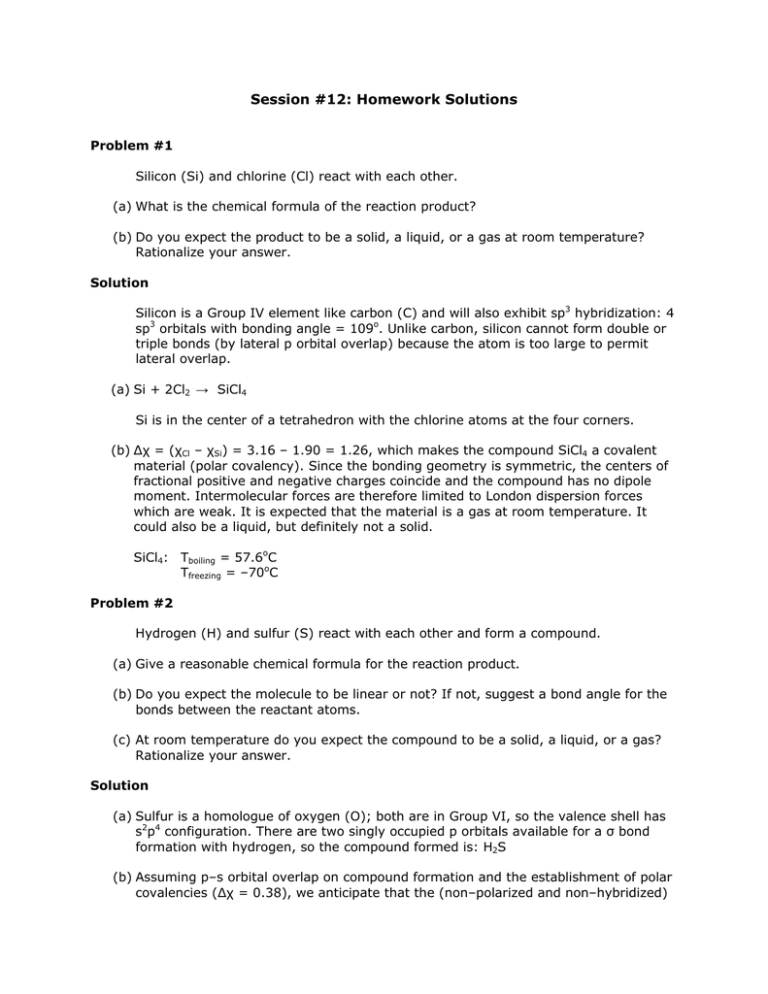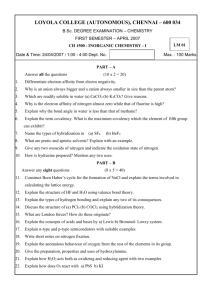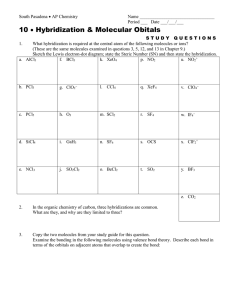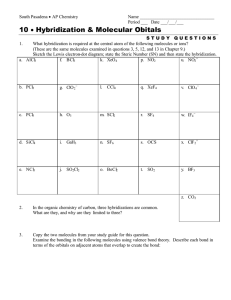Session #12: Homework Solutions
advertisement

Session #12: Homework Solutions Problem #1 Silicon (Si) and chlorine (Cl) react with each other. (a) What is the chemical formula of the reaction product? (b) Do you expect the product to be a solid, a liquid, or a gas at room temperature? Rationalize your answer. Solution Silicon is a Group IV element like carbon (C) and will also exhibit sp3 hybridization: 4 sp3 orbitals with bonding angle = 109o. Unlike carbon, silicon cannot form double or triple bonds (by lateral p orbital overlap) because the atom is too large to permit lateral overlap. (a) Si + 2Cl2 → SiCl4 Si is in the center of a tetrahedron with the chlorine atoms at the four corners. (b) Δχ = (χCl – χSi) = 3.16 – 1.90 = 1.26, which makes the compound SiCl4 a covalent material (polar covalency). Since the bonding geometry is symmetric, the centers of fractional positive and negative charges coincide and the compound has no dipole moment. Intermolecular forces are therefore limited to London dispersion forces which are weak. It is expected that the material is a gas at room temperature. It could also be a liquid, but definitely not a solid. SiCl4: Tboiling = 57.6oC Tfreezing = –70oC Problem #2 Hydrogen (H) and sulfur (S) react with each other and form a compound. (a) Give a reasonable chemical formula for the reaction product. (b) Do you expect the molecule to be linear or not? If not, suggest a bond angle for the bonds between the reactant atoms. (c) At room temperature do you expect the compound to be a solid, a liquid, or a gas? Rationalize your answer. Solution (a) Sulfur is a homologue of oxygen (O); both are in Group VI, so the valence shell has s2p4 configuration. There are two singly occupied p orbitals available for a σ bond formation with hydrogen, so the compound formed is: H2S (b) Assuming p–s orbital overlap on compound formation and the establishment of polar covalencies (Δχ = 0.38), we anticipate that the (non–polarized and non–hybridized) p–p bond angle is not 90o but likely more, and 100o appears a reasonable number. (It is frequently stated that the large bonding angle in H2O and homologues can best be explained by involving sp3-type hybridization.) (c) The compound is expected to be a gas – not so much because of the smaller dipole moment compared to H2O, but because of the absence of hydrogen bonding. Problem #3 What types of bonds can be expected to be formed in each of the compounds listed below, and in what “state of aggregation” (gaseous, liquid or solid) are they encountered at room temperature? (a) O2 (b) HCl (c) SiO2 (d) LiF (e) CH4 Solution (a) O2 is a gas at room temperature. It is customary to present the bonding as the formation of two unspecified covalent bonds: This presentation is, however, inconsistent with the observed paramagnetism which demands the existence of an unpaired electron – consequently it is now frequently rewritten as: which in turn is not in line with the experimentally determined bond energy. (b) HCl is a gas at room temperature. (p + s → σ orbital) Δχ = 0.9 polar covalency (c) SiO2 could be written as O=Si=O, but this would be incorrect! Si Si, like C, is subject to sp3 hybridization and forms four equivalent hybrid orbitals directed with 109o bond angles at the corners of a tetrahedron. At each corner is located an oxygen atom which forms a bridge to another silicon with tetrahedral bond configuration – we obtain an ordered 3–dimensional structure. In planar presentation we would write: The Si–O bond is a polar covalency with the Si-O-Si bond angle being stressed out of their 90o (p) configuration. SiO2 is a solid at room temperature. (Your answer is acceptable if you say sp3 hybridization leading to polar covalency.) (d) Electron transfer and ionic bond formation: Li+F–. We have the formation of a solid at room temperature. (e) CH4 has sp3 hybridization, forming a tetrahedron with 109o bond angles. The four σ bonds are polarized. CH4 is a gas at room temperature. Problem #4 One of the two compounds, NH3 or BF3, is found to exhibit a permanent dipole moment. Identify the polar species and account for the different bonding characteristics of the two species. Make appropriate sketches of the respective bonding configurations. Solution The answer to this question is found by looking at the valence shell configurations: B: 2s2p1 N: 2s2p3 We realize that boron can hybridize into a planar sp2 bonding configuration and form three σ bonds with fluorine. The compound is expected to be internally polarized, but no permanent dipole will thus result because of the bonding symmetry. Nitrogen has three singly occupied 2p orbitals directed at right angles to each other. Upon σ bond formation in NH3, we anticipate a pyramidal configuration with nitrogen at the apex. Because of bond polarization (Δχ = 0.82), mutual repulsion of the activated hydrogen atoms is anticipated to increase the bond angle (which is found to be 105o). In fact, the large bond angle observed in NH3 suggests sp3 hybridization similar to that invoked in H2O. In either case, the resulting molecule will exhibit a permanent dipole moment. planar, non-polar sp3 hybridization, polar Problem #5 Account for the following fact: H2O and HF have much higher boiling points (100oC and 19.4oC respectively) than their homologues, H2S and HCl (–60.7oC and –85oC), although the molecular weight of H2O and HF is lower than that of H2S and HCl. Solution Because O and F are more electronegative than S and Cl, H2O and HF form stronger hydrogen bonds than H2S and HCl. These strong hydrogen bonds increase the intermolecular forces enough in H2O and HF to more than compensate for the higher weight of H2S and HCl, and cause H2O and HF to have significantly higher boiling points than their homologues. MIT OpenCourseWare http://ocw.mit.edu 3.091SC Introduction to Solid State Chemistry Fall 2009 For information about citing these materials or our Terms of Use, visit: http://ocw.mit.edu/terms.





